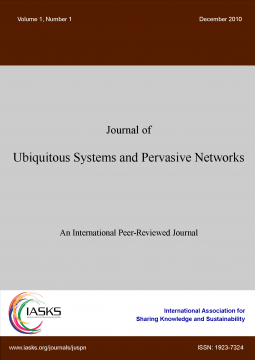volume-05-Issue 1 (2014)
Latest Articles
Feedback Provision on Running Technique with a Smartphone
JUSPN, volume-05, Issue 1 (2014) , PP 25 - 31
Published: 01 Jan 2014
DOI: 10.5383/JUSPN.05.01.004
by Christina Strohrmann, Julia Seiter, and Gerhard Tröster from Wearable Computing Lab., ETH Zurich, Zurich, Switzerland
Abstract: Most runners run by themselves and do not have access to a trainer for feedback on their running form. We thus investigated the use of a standard smartphone for feedback provision while running, which is available to almost everyone. We investigated the use of body-worn sensors for assessing running technique on the example of arm carriage. In a pre-study with 10 runners, we found that arm carriage can be monitored by a single sensor on the upper arm. We developed an Android application to monitor arm carriage in real time. The application was validated in a user study with 23 participants. Results from questionnaires revealed high user acceptance read more... read less...
Keywords: Wearable Technology, Running, Feedback, Signal Processing
Dynamic Service Composition for Telecommunication Services and Its Challenges
JUSPN, volume-05, Issue 1 (2014) , PP 17 - 24
Published: 31 Dec 2013
DOI: 10.5383/JUSPN.05.01.003
by S.M.F.D Syed Mustapha, Hui Na Chua from Faculty of Information and Technology, Universiti Tun Abdul Razak, Malaysia Faculty of Science and Technology Science, Sunway University, Malaysia
Abstract: As communication networks have evolved towards IP (Internet Protocol) networks, telecommunication operators has expanded its reach to internet multimedia web content services while operating circuit-switch networks in parallel. With the adoption of SOA (Service Oriented Architecture) that enables service capability interfaces to be published and integrated with other service capabilities into new composite service, service composition allows telecommunication providers to accelerate more new services provisioning. From the perspective of telecommunication providers to deliver integrated composite service from different providers and different network protocols, this paper is aimed to present the current service composition based on middleware approaches; discuss the requirements of meeting the challenges; and compare the approaches. read more... read less...
Keywords: Service Composition Converged Services, Middleware.
Electromagnetic Energy and Data Transfer for a Neural Implant
JUSPN, volume-05, Issue 1 (2014) , PP 09 - 16
Published: 31 Dec 2013
DOI: 10.5383/JUSPN.05.01.002
by Navid Rezaei, Deyasini Majumdar, Bruce Cockburn, Christian Schlegel from Department of Electrical and Computer Engineering, University of Alberta, Edmonton, Canada, T6G 2V4 Department of Electrical and Computer Engineering, Dalhousie University, Halifax, Canada,
Abstract: The wireless transfer of energy through living tissues for the purpose of data communications is investigated. After considering the best frequency band for communications in biological tissues, both the uplink and downlink near-field coupled energy transfer options are analyzed. The possibility of wireless powering using the same frequency band is also studied. The nominal power consumption of the implantable baseband communications circuitry was estimated for smaller technology nodes using the Synopsys CAD tools. The effect of using the ultra-low power subthreshold operation in different technology nodes was also analyzed using predictive technology models. By introducing an analysis flow and the corresponding implementation code, we were also able to predict the subthreshold power consumption of the circuitry in different technology nodes and importantly at the gate level. read more... read less...
Keywords: near-field, link budget, implant, wireless communications, ultra-low power, subthreshold
Detecting Primary User Emulation Attacks in Cognitive Radio Networks via Physical Layer Network Coding
JUSPN, volume-05, Issue 1 (2014) , PP 01 - 08
Published: 31 Dec 2013
DOI: 10.5383/JUSPN.05.01.001
by Xiongwei Xie, Weichao Wang from Department of SIS, UNC Charlotte, Charlotte, NC, 28223, USA
Abstract: Primary user emulation (PUE) attacks on cognitive radio networks pose a serious threat to the deployment of this technique. Previous approaches usually depend on individual or combined received signal strength (RSS) measurements to detect emulators. In this paper, we propose a new mechanism based on physical layer network coding to detect the emulators. When two signal sequences interfere at the receiver, the starting point of collision is determined by the distances among the receiver and the senders. Using the signal interference results at multiple receivers and the positions of reference senders, we can determine the position of the ‘claimed’ primary user. We can then compare this localization result with the known position of the primary user to detect the PUE attack. We design a PUE detection mechanism for wireless networks with trustworthy reference senders. We analyze the overhead of the proposed approach and study its detection accuracy through simulation. read more... read less...
Keywords: Cognitive Radio Networks, Primary User Emulation, Physical Layer Network Coding.

